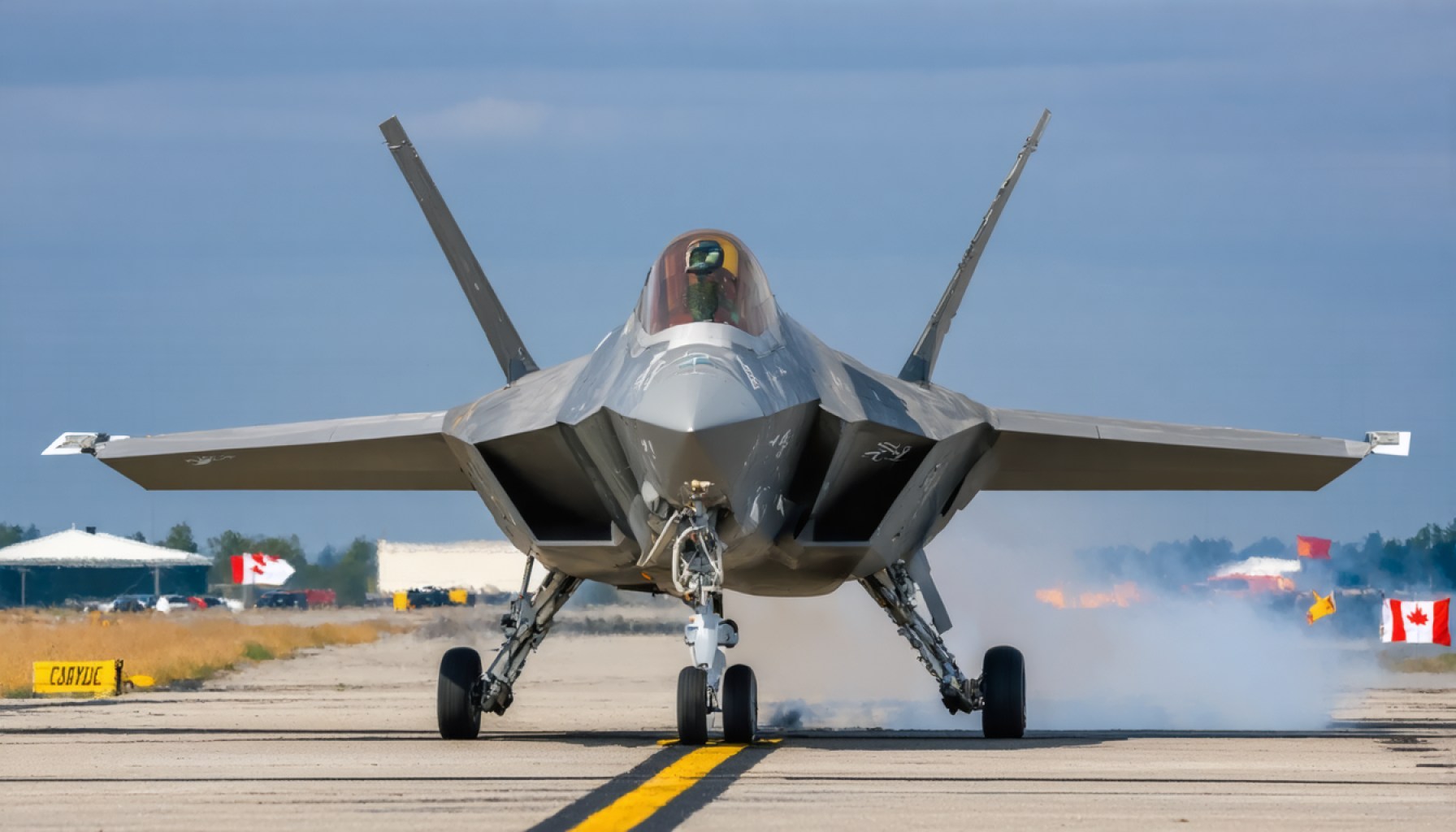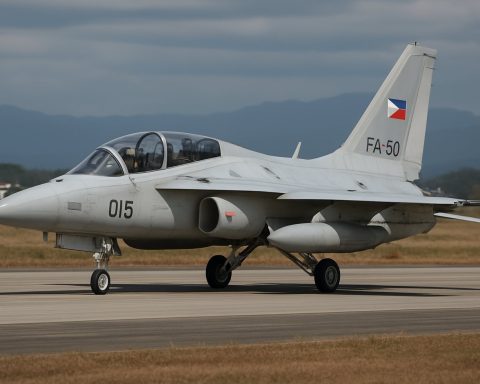- Canada faces a crucial decision regarding its $13.2 billion deal for 88 American-made F-35 stealth fighters, intended to replace its aging CF-18 fleet.
- This decision is complicated by political tensions with the Trump administration and a need to align defense investments with global changes.
- Defense Minister Bill Blair advocates revisiting the F-35 contract terms to ensure alignment with Canada’s national interests.
- Potential alternatives to the F-35 include Sweden’s Saab Gripen, France’s Dassault Rafale, and Europe’s Eurofighter Typhoon, none matching F-35’s stealth capabilities.
- Experts warn that canceling the F-35 deal might compromise Canada’s defense, particularly in the Arctic.
- The decision impacts national security and sovereignty, requiring a balance between political tensions and long-term defense strategy.
- Canada’s choice will shape air defense capabilities and influence its future strategic position.
The icy winds of diplomatic tension have swept across North America, casting a shadow over Canada’s defense strategy. As Ottawa stands on the precipice of a monumental decision, it faces a complex puzzle: whether to continue with its $13.2 billion deal for 88 American-made F-35 stealth fighters—a fleet poised to replace the aging CF-18s of the Royal Canadian Air Force. This conundrum comes partially fueled by political frictions with the Trump administration, which have stirred the northern nation’s contemplation of alternatives.
Newly reappointed Defense Minister Bill Blair has suggested that the time has come to revisit the terms of the F-35 contract. This reconsideration, he argues, is critical to ensuring that Canada’s defense investments align with the changing global landscape and its own national interests. Canada remains legally committed to acquiring the first batch of 16 jets, yet the broader future of the deal hangs in the balance.
The F-35, celebrated for its cutting-edge stealth capabilities and technological superiority, is not without contenders. On the table are Sweden’s agile Saab Gripen, France’s versatile Dassault Rafale, and Europe’s robust Eurofighter Typhoon. Each of these potential substitutes offers unique strengths, yet none can claim the unparalleled stealth prowess of Lockheed Martin’s F-35—a characteristic crucial for safeguarding Canada’s vast Arctic frontiers.
As the quiet hum of diplomacy resonates above Ottawa, experts issue stern warnings of the potential consequences of canceling the F-35 deal. Without the unmatched strategic advantage of this fifth-generation fighter, Canada may find itself vulnerable to threats in one of the world’s most strategically significant regions: the Arctic. The F-35 was not chosen on a whim; it represents a commitment to national security in a region of increasing global interest.
Canada’s leadership stands before a pivotal decision that extends beyond mere procurement. It touches upon the very essence of its sovereignty and security. While seeking alternatives amid diplomatic strains might appear politically savvy, it is vital that this choice considers the long-term implications for defense capabilities. The delicate balance between political tensions and national security demands a measured, forward-thinking approach.
Canada’s deliberation over the F-35 embodies a broader narrative—the intricate intersection of defense, diplomacy, and national interest. In these critical moments, Ottawa’s choice will define its air defense capability for decades, shaping the nation’s ability to fly high and free in an unpredictable world.
Canada’s Fighter Jet Dilemma: Strategic Choices in a Changing Global Landscape
Understanding the F-35 Stealth Fighter Deal
The decision-making process behind the acquisition of the F-35 stealth fighters involves a consideration of numerous factors, not solely limited to diplomatic relations. Here are some additional insights and considerations that were not fully explored in the original article:
Pros and Cons of the F-35 Stealth Fighters
Pros:
– Stealth Capability: The F-35 is renowned for its advanced stealth technology, which allows it to evade radar detection and perform critical missions without being detected.
– Advanced Systems: Equipped with state-of-the-art sensor fusion and electronic warfare capabilities, the F-35 enhances situational awareness for pilots.
– Interoperability: As a widely adopted fighter among NATO allies, the F-35 facilitates joint military operations and strengthens strategic partnerships.
Cons:
– High Cost: With a price tag of $13.2 billion, the financial commitment required for the F-35 is substantial, potentially impacting other defense priorities.
– Maintenance Challenges: The complex systems within the F-35 require significant maintenance and support infrastructure.
Alternatives to the F-35
Canada’s consideration of alternatives like the Saab Gripen, Dassault Rafale, and Eurofighter Typhoon each offers distinct advantages:
– Saab Gripen: Known for its affordability and operational efficiency, it might be a cost-effective choice with proven performance.
– Dassault Rafale: Versatile with proven combat capability, it has been successfully used by several NATO members.
– Eurofighter Typhoon: Offers robust performance in air-to-air combat with strong European Union support behind its development.
Potential Impacts on Canada’s Defense Strategy
Experts caution against the consequences of moving away from the F-35:
– Arctic Security: As global interest in the Arctic increases, maintaining advanced defense capabilities becomes crucial in safeguarding Canadian sovereignty in the region.
– Technological Edge: Canada may lose a competitive edge in defense capabilities if it opts for less advanced fighter technology.
– Alliance Dynamics: Backing out of the F-35 deal would impact Canada-U.S. relations and the broader NATO defense strategy.
Real-World Use Cases and Political Controversies
Canada’s choice reflects a broader trend where national defense decisions are influenced by both international diplomacy and domestic politics:
– Geopolitical Tensions: Ongoing friction with the U.S. administration could influence the decision, yet security interests must take precedence over political disagreements.
– Economic Considerations: Defense spending decisions have ripple effects on the Canadian economy and defense industry jobs.
Insights and Recommendations
To make an informed decision, Canada should:
– Conduct a comprehensive assessment of strategic defense needs, considering both current threats and future geopolitical landscapes.
– Evaluate long-term financial implications, including maintenance and operational costs of various fighter options.
– Consider partnership opportunities for joint defense initiatives with allied nations.
Actionable Tips for Canada
– Continue diplomatic discussions to smooth tensions with the U.S. while prioritizing national defense needs.
– Engage with defense experts to evaluate the latest technological advancements and options available.
– Foster public transparency and discussion on defense investments to gain broader support and understanding from Canadian citizens.
Conclusion
Canada’s decision about its air defense strategy is not just a question of choosing a fighter plane. It fundamentally touches on national security, international relationships, and economic priorities. As Canada stands at this crossroads, it is essential to weigh the pros and cons carefully, ensuring that future choices reflect prudent foresight and national interests.
For further information, visit Canada’s Government Website.







